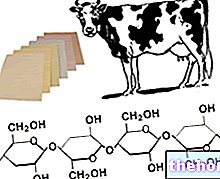- Linoleic acid (AL or LA), progenitor of the omega 6 fatty acids;
- Alpha linolenic acid (AaL or ALA), progenitor of the omega 3 series.

Once introduced through the diet, essential fatty acids are metabolized and transformed into other fatty acids belonging to the same series, thanks to the intervention of enzymes called elongases and desaturases.
These derived fatty acids have specific properties, both from a functional and structural point of view.
The fatty acids derived from LA and ALA are, respectively
- Omega 6: gamma linolenic acid (GLA), linolenic dihomogamma acid (DGLA) and arachidonic acid (AA).
- Omega 3: eicosapentaenoic acid (EPA) and docosahexaenoic acid (DHA).
Although not really essential, arachidonic acid can become so with a lack of linoleic acid or due to the inability to convert it at the metabolic level.
The foods most used in the Western diet are richer in omega 6 than omega 3.
Although the only fatty acids considered "really" essential are ALA and LA, research bodies also suggest a minimum level of intake for EPA and DHA (omega 3). By virtue of the great importance they have for human health, the safety contribution for EPA and DHA serves to avoid their deficiency.
The national reference body is SINU - Italian Society of Human Nutrition - which established the Recommended Intake Levels of Nutrients and Energy for the Italian population (LARN).
and in the germ or embryo of other seeds (including starchy ones).
From the oil seeds and the germ (sometimes including bran) it is possible to obtain an even more concentrated oil of ALA (but also of vitamin E, other vitamins, antioxidant minerals, etc.).
The table below summarizes some of the richest sources of alpha linolenic acid known today.
† average value
Bibliography:
- Beare-Rogers. "IUPAC Lexicon of Lipid Nutrition" (pdf). Archived (PDF) from the original on 12 February 2006. Retrieved 22 February 2006.
- Seed Oil Fatty Acids - SOFA Database Retrieval
- Li, Thomas S. C.. "Sea buckthorn: New crop opportunity". Perspectives on new crops and new uses. Alexandria, VA: ASHS Press. pp. 335–337. Archived from the original on 22 September 2006. Retrieved 2006-10-28.
- "Omega-3 fatty acids". University of Maryland Medical Center.




























